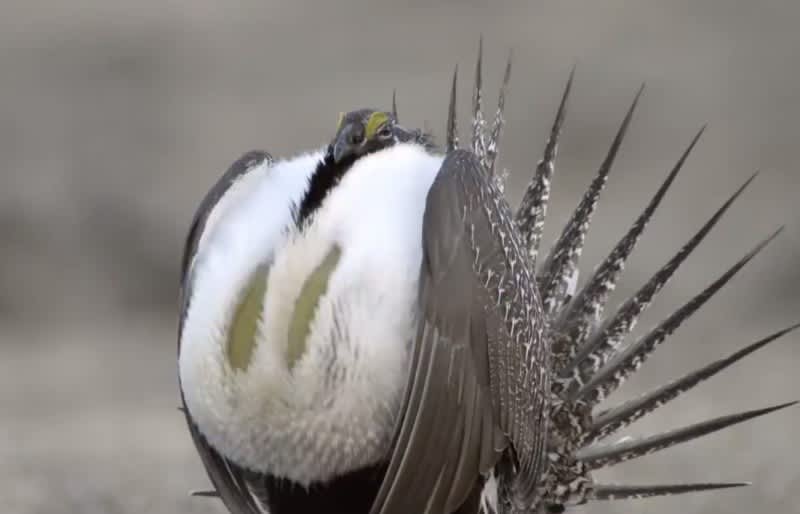USFWS Decides to Keep Greater Sage-grouse Off Endangered List
OutdoorHub Reporters 09.23.15

On Tuesday, the US Fish and Wildlife Service (USFWS) made the momentous decision to not list the greater sage-grouse under the Endangered Species Act.
For some time, the bird had been at the heart of a debate that pitted environmentalists against industry advocates, and conservationists against land developers. This week, the Department of the Interior concluded the long debate by publishing a 341-page report that detailed why the bird is not likely to find a spot on the endangered species list anytime soon.
“This is truly a historic effort—one that represents extraordinary collaboration across the American West,” said U.S. Secretary of the Interior Sally Jewell in a press release.
According to federal officials, an unprecedented, large-scale effort to preserve the species has reduced threats to sage-grouse across 90 percent of its breeding habitat in 11 Western states. Due to the bird’s current population status and good prospects for the future, the USFWS determined that the species is not at risk of extinction now or in the near future.
“The epic conservation effort will benefit westerners and hundreds of species that call this iconic landscape home, while giving states, businesses and communities the certainty they need to plan for sustainable economic development,” Jewel said.
Such a massive conservation effort would not have been possible if not for the collaboration from many diverse and passionate groups. Hunters, environmentalists, animal rights advocates, ranchers, land owners, and government agencies all pitched in for the campaign to restore and protect sage-grouse habitat.
You can watch Secretary Jewell’s address below:
Greater sage grouse does not require endangered species act pr…Breaking: Thanks to the largest land conservation effort in U.S. history, the greater sage grouse does not need protection under the Endangered Species Act. Here’s why this collaborative conservation effort is a huge #WildlifeWin
Posted by U.S. Department of the Interior on Tuesday, September 22, 2015
“Today’s decision reflects the joint efforts by countless ranchers and partners who have worked so hard to conserve wildlife habitat and preserve the Western way of life,” said US Agriculture Secretary Tom Vilsack. “Together, we have shown that voluntary efforts joining the resources of private landowners, federal and state agencies, and partner organizations can help drive landscape-level conservation that is good for sage-grouse, ranching operations, and rural communities.”
The sage-grouse once ranged across more than 290 million acres of land in the West. Today’s population only occupies a fraction of that range, but USFWS biologists have determined that the species is still widely distributed. Population counts, however, have been falling and may continue to fall until the effects of recent conservation efforts can be felt.
Researchers say the sage-grouse is not only vital in of itself, but also because the bird is an indicator of how healthy sagebrush habitat is. Numerous other species, including mule deer, pronghorn, elk, and eagles, share the sage-grouse’s territory. The controversial debate to protect the sage-grouse is seen by many as the symbolic struggle between those who want to protect wildlife habitat, and those who advocate industry and development on the same land. The USFWS decision to not list the sage-grouse did not please everyone, and some activists view the decision as a victory for developers rather than wildlife.
“Like other politicians before her, today Secretary Jewell declared victory before the battle is actually won,” Erik Molvar, a biologist for WildEarth Guardians, told USA Today. “The government’s plans fall far short of ensuring this iconic, imperiled bird is protected from the serious threats posed by fossil fuel extraction, grazing and development.”
Other groups, such as the Theodore Roosevelt Conservation Partnership (TRCP), saw the decision as a positive one.
“Sportsmen’s groups are encouraged by the decision and appreciative of the 11 states, federal agencies, private landowners, and other vested stakeholders that have come together in a daunting, often controversial effort,” TRCP stated in a press release.
Conservation groups warn that the hard work is not over. In order to not only survive but thrive, efforts to conserve the imperiled bird must continue.
“For years, sportsmen, ranchers, developers, and biologists have anxiously awaited the day when the sage grouse listing decision would be made,” says Steve Riley, president and CEO of the North American Grouse Partnership. “Now, it is imperative that these collective conservation efforts are implemented and monitored for effectiveness in the long-term if we are to avoid winding up with sage grouse again at risk further down the road.”
Conservation leaders say that federal and state agencies must continue to follow through collaborative conservation work, and that sportsmen and women must continue to oppose attempts by lawmakers to hinder those plans.

